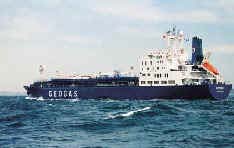| Highlights on the three main product markets Before proceeding into the analysis of each market segment, one has to stress
again the increased development on behalf of ship owners or tonnage operators for further
concentration and consolidation of ships control, by size and market segments. This trend
which started a few years back with pooling agreements between smaller independent owners
has now developed into tonnage swap between larger shipping groups according to respective
size of ships; each party taking a firm commitment by mean of time charter agreements.
All sizes have been affected with mainly Bergesen, Exmar, Bibby, AP
Møller and Hydro on the larger size segment (VLGC and midsize tonnage); AP Møller,
Hydro, Shulte, Latvian on the 15-20,000 cbm size segment; whilst further moves were lately
announced on the smaller units with Schulte entering the Unigas pool and Gaschem and
Medgas pool joining forces to market their ships. LGS, now controlling 15 ships on their
own, have decided to withdraw from the Unigas pool and market their ships separately.
Those moves have generated a new situation where less but larger
shipping actors are creating extensive shipowning or controlling groups aiming to act as
fully integrated "industrial" partners looking for more security and, maybe,
less market exposure.
- LPG - more volatility on product price and shipping activity
The continuous and permanent distortions of the LPG pricing system have
given an increasingly double edged market - the physical side and the paper side. Shipping
is obviously closer to the physical market and affected by its greater volatility and
often irrational shipping routes due to product pricing differentials.
It is interesting to note that the Brent propane price ratio of 230% in
January 1996 came down to 110% by January 1998 with a 30% decrease on the Brent value
itself.
Cautious attitude by main operators has been generated by:
- slowing down of imports into the Far East (Japan and mainly Korea)
despite China's continued healthy demand;
- cutbacks of supplies from the Middle East;
- new availability of land storage capacity in China to cope with
additional imports;
- additional production in North and West Africa;
- and pressure on US prices.
Apart from a few renewals of time charter coverage, mainly on behalf of
large oil majors or producers, the general market trend was calling for late consolidation
moves rather than anticipated trading positions, and a general attitude calling for more
caution and less shipping exposure was the on-going momentum.
Let us also note that statistics now available prove that 1998 has been
globally the warmest year since first measures were taken in 1880. Nonetheless it seems
more and more that climate and temperature elements are of minor effect in the general
market fluctuations.
 |
Victoire
17,500 cbm, blt 1990
by IH,
owned by Geogas Trading,
Geneva |
- Anhydrous ammonia - fluctuations but a general weakening of price
With the development of new production plants in the east of Suez and in
the Caribbean Basin, the main feature of this traffic is a slow reduction of long haul
traffic, such as cargo movements from the Black Sea to the US Gulf or sometimes to India,
to the benefit of more regular intra-Continental movements, such as inter-Caribbean,
inter-Europe and inter-Middle East Gulf / South East Asia traffics. Overall quite a
reasonable year for shipping, with healthy levels, achieved by this segment of ships
(20-50,000 cbm), despite some occasional idle time which is the permanent worry of
shipowners involved in such commodity traffic.
- Petrochemical gases - recovery yet to come for shipping
As anticipated since last year, the crisis in Asia had severe
repercussions on the international petrochemical scene, especially during the first half
of 1998, and the general slowdown of activity already under way since 1997 continued
further with some production cutbacks taking place in the Asian Basin.
Thanks to some welcome maintenance outages at several petrochemical
plants in Europe, a good number of supporting ethylene movements were concluded from the
US Gulf and Mexico to Europe. Nonetheless severe pressure on product price could not be
avoided; this leading to further pressure on freight rates.
Propylene demand in Asia remained low and mainly supplied by local
production, but some light was seen over third and fourth quarters with some additional
demand which was readily covered from Libya and the Middle East.
Finally the VCM segment, which used to be the commodity giving the
largest potential employment to the larger semi refrigerated ships (8,000 to 20,000 cbm),
has dried up further on the long haul trips, leaving only a few contractual cargoes from
US Gulf to the Far East, and smaller parcels from US Gulf to East Mediterranean at a
squeezed level of freight. An illustration of the price disturbances for this commodity
was the drop of the average value cif Korea and Taiwan from $500/tonne at the end of 1997
to $310/tonne at end 1998.
Last but not least, the traditional butadiene/C4 transatlantic run gave
a tough time and little satisfaction to shipowners involved in such traffic. The smooth
combination of small parcels on one single ship loading at several ports in Mediterranean
/ Continent for discharge in the Caribbean / US Gulf is more and more difficult to
achieve. Here, also, a permanent pressure on the price of the product took place in the
USA, giving some substantial fluctuations in trading opportunities and transportation
possibilities.
|